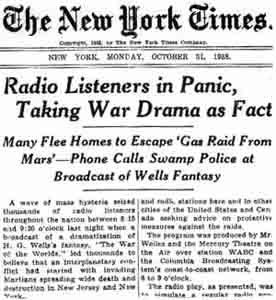On October 30, 1938, a now infamous radio show put listeners’ skeptical skills to the test. According to a news bulletin that interrupted the supposed sounds of the Ramón Raquello orchestra live from the Meridian Room of the Park Plaza Hotel, Martians had landed in New Jersey and were running amok destroying everything in sight.
No, it wasn’t the Jersey Shore kids, but a play based on H.G. Wells’ War of the Worlds. This Orson Welles’ version resulted in panic throughout the country, or as The New York Times reported on Halloween day: “A wave of mass hysteria seized thousands of radio listeners between 8:15 and 9:30 o’clock last night.” Boo, indeed!
Hadley Cantril in his classic 1940 study of the psychology of panic, “The Invasion from Mars,” estimated that at least 6 million people, possibly as many as 12 million, tuned in to the show at some point that October evening. Of those, approximately 1.7 million listeners thought it was a real news show and 1.2 million of them panicked to some degree — a lot, but not even close to a majority. While demonstrating the power of specific social and psychological factors contributing to the panic, Cantril’s research clearly pointed out the important role of critical-thinking abilities in determining whether the show was a play or a live news event.

Studies demonstrated that one of the primary reasons for misunderstanding the show was tuning in late. Many had been listening to the rival top-rated show, Edgar Bergen and Charlie McCarthy (yeah, a ventriloquist on radio!), and when they switched stations, most missed the opening disclaimer that this was a fictional play of H.G. Wells’ classic sci-fi novel.
But not all the late-comers were fooled. Many using critical skills analyzed internal evidence and decided the event was not real. For example, they recognized Orson Welles’ distinctive voice, or figured that there was no way reporters could drive from New York City to distant parts of New Jersey within minutes of the first sightings to give a live on-the-air update. Others checked the newspaper to see it listed in the “radio guide” for that evening, turned to other stations and noticed it was not news there, or simply looked out the window to see whether there were fires and crowds of people streaming away from attacking Martians.
Yet, the power of selective perception runs wild. As reported in Cantril’s study, people who panicked tended to have personalities more prone to suggestion and susceptibility; they were often gullible and phobic worriers, religious and lower in self-confidence; and they tended to be less educated with lower critical abilities.
For example, when determining whether the show was real by turning to another radio station, the panickers claimed to hear religious music: “I was sure a lot of people were worshiping God while waiting for their death.” Or, upon hearing music said, “Nero fiddled while Rome burned.” Others who looked out the window even had selective sensory responses: “thought I could smell the gas. And it felt as though it was getting hot, like fire was coming.” But most tellingly is this response from a frightened listener: “I knew it was some Germans trying to gas all of us. When the announcer kept calling them people from Mars, I just thought he was ignorant and didn’t know yet that Hitler had sent them all.”
And here we have the key sociopolitical reasons, besides fearful personalities, to explain why skeptical skills failed.
Hey, kids!
Click here for the script to the original broadcast!
We must keep in mind that critical thinking sometimes is put to the test even among the less phobic and more educated skeptical listeners. Social context can make a difference. People who were listening to the show without family members nearby, or were told to listen to the show by a scared neighbor or friend, were more likely to panic, according to Cantril.
Of course, in 1938, before television, most people kept up with the news about Hitler and Europe by listening to the radio. America was emerging from the Depression and listeners with economic worries tended to be more susceptible to suggestion. Comic strips and radio shows like Buck Rogers and other mysteries of science and advances in technology received media attention throughout the 1930s, so stories of visitors from outer space seemed plausible to some listeners.

Peter Nardi discusses how to use our critical skills to avoid scams, respond to rumors and debunk questionable research.
Still, those time-specific causes only go so far — the same radio play, broadcast in Spanish, caused a similar panic in Ecuador 11 years later.
Developing critical ability and constructive skepticism clearly does not always inoculate us from moments of emotional panic, especially when the context is most threatening. Cantril stated it well: “If critical ability is to be consistently exercised, it must be possessed by a person who is invulnerable in a crisis situation and who is impervious to extraneous circumstances.”
So this Halloween, when the news media scare us with warnings about razor blades in apples and tainted candy, remember not all stories told are real.
Fear of needles, blades and poison lurking in trick-or-treaters’ candy bags is way out of proportion to verified incidents and perhaps just as unreal as this old radio show.
So, relax, put on a scary movie or listen to the original “War of the Worlds” broadcast, and enjoy the little green people and other UFO-costumed kids who ring your doorbell. Boo, indeed!


